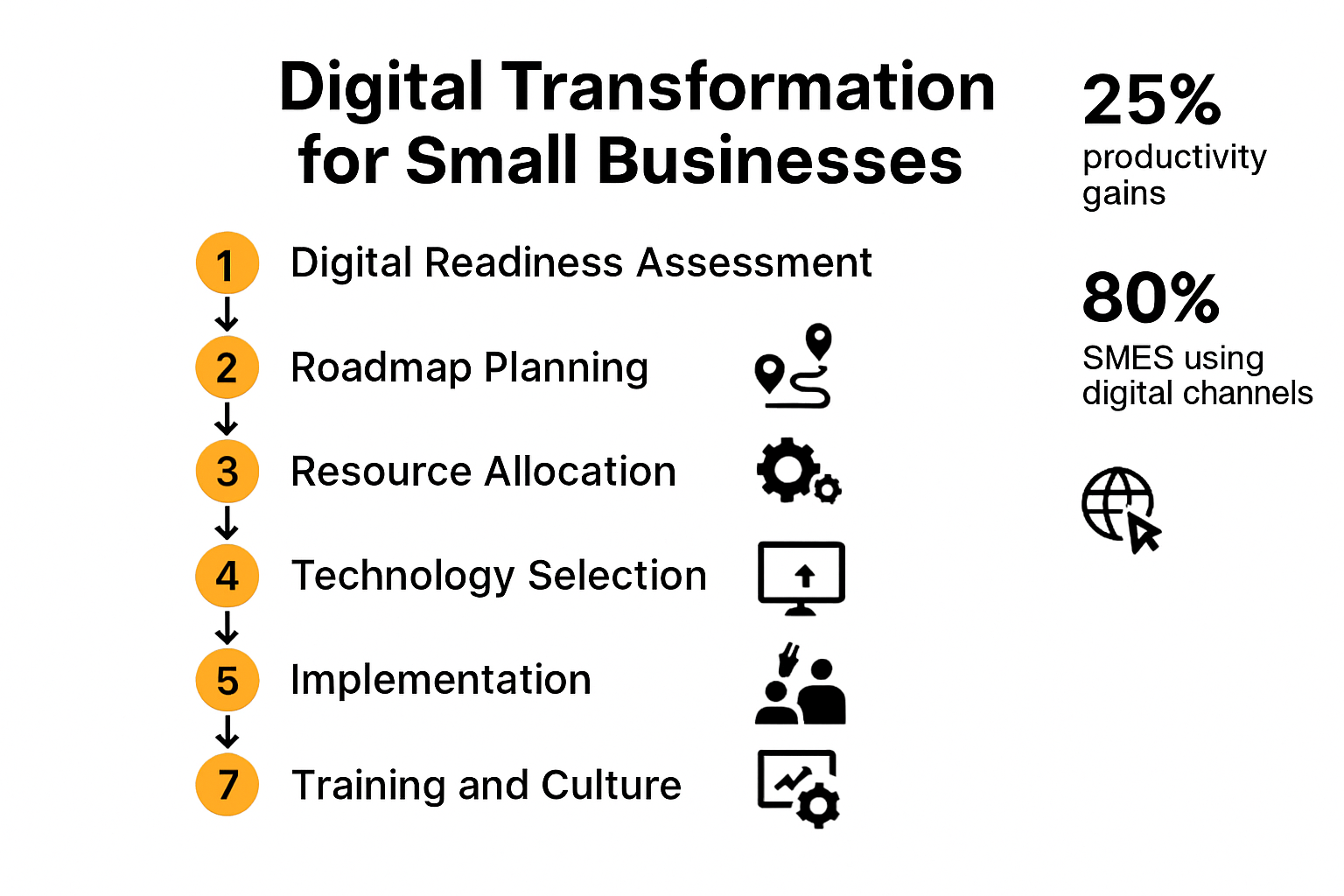Digital transformation sounds like a big business buzzword but small businesses are grabbing the spotlight. More than 80 percent of SMEs now use website articles and social media as their main marketing channels. Most small business owners imagine digital upgrades come with hefty costs or confusing tech jargon. The real shock is that the biggest difference comes from simple, strategic shifts across just seven clear steps and these changes can bring productivity gains of up to 25 percent. Curious how a step-by-step approach could transform your business future?
Table of Contents
- Understanding Digital Transformation Needs
- Planning Your Digital Transformation Steps
- Implementing Technologies For Marketing Success
- Overcoming Common Digital Transformation Challenges
Quick Summary
| Takeaway | Explanation |
|---|---|
| Understand your digital readiness | Conduct a thorough assessment of current technology and workforce skills before initiating transformation efforts. |
| Develop a strategic roadmap | Create a detailed plan that outlines specific initiatives, timelines, and resource needs aligned with business objectives. |
| Allocate resources wisely | Balance investments in technology with training and change management to ensure effective implementation. |
| Choose marketing technologies carefully | Select user-friendly tools that integrate well with existing systems and align with your business’s growth goals. |
| Foster a culture of continuous learning | Encourage experimentation and adaptability within your team to navigate the ongoing digital transformation journey effectively. |
Understanding Digital Transformation Needs
Digital transformation represents a fundamental reimagining of how small businesses operate and deliver value to customers. This process goes beyond simply adopting new technologies it requires a strategic approach to integrating digital solutions that fundamentally change business operations and customer experiences.
The Reality of Digital Transformation for Small Businesses
Small businesses face unique challenges when considering digital transformation. Unlike large corporations with extensive resources, small enterprises must be strategic and targeted in their approach. Research from McKinsey suggests that successful digital transformation is not about massive technological investments but about creating adaptable digital capabilities that drive business growth.
The core challenge for many small businesses is understanding where digital transformation can create the most significant impact. This means identifying specific areas where digital tools can solve existing problems, improve efficiency, or create new opportunities. Deloitte’s Digital Transformation Report highlights that businesses that effectively leverage digital technologies can see productivity improvements of up to 25%.
Key Drivers of Digital Transformation
Multiple critical factors push small businesses towards digital transformation. Customer expectations have dramatically shifted consumers now expect seamless digital experiences, personalized interactions, and instant access to services. Competitive pressures also play a significant role small businesses that fail to adapt risk being left behind by more technologically agile competitors.
To help small business owners understand the main drivers pushing digital transformation, the table below summarises the key factors and how they impact businesses:
| Driver | Description |
|---|---|
| Customer Expectations | Demand for seamless, personalised, and instant digital experiences from businesses |
| Competitive Pressures | Need to adapt or risk being overtaken by more technologically agile competitors |
| Operational Efficiency | Automation and streamlined processes free up human resources and reduce errors |
| Economic Landscape Changes | External events (e.g., COVID-19 pandemic) making digital adaptability essential |
| Continuous Improvement Focus | Ongoing process of innovation and adaptation to maintain resilience and competitiveness |
Operational efficiency emerges as another crucial driver. Digital tools can automate repetitive tasks, reduce manual errors, and free up human resources for more strategic work. Our guide on digital marketing strategies provides deeper insights into how digital technologies can streamline business processes.
The economic landscape has also fundamentally changed. The COVID-19 pandemic accelerated digital adoption across industries, making technological adaptability not just an advantage but a necessity. Small businesses that can quickly implement digital solutions demonstrate greater resilience and flexibility in challenging market conditions.
Ultimately, digital transformation is not about technology for technology’s sake. It is a strategic approach that requires careful planning, understanding of business goals, and a commitment to continuous learning and adaptation. Small businesses must view digital transformation as an ongoing journey of innovation and improvement, not a one-time technological upgrade.
By recognizing the strategic importance of digital transformation and approaching it methodically, small businesses can unlock new opportunities, enhance customer experiences, and build a more competitive and resilient business model.
Planning Your Digital Transformation Steps
Planning a digital transformation journey requires strategic thinking, careful assessment, and a systematic approach. Small businesses must move beyond random technology adoption and develop a comprehensive roadmap that aligns technological investments with core business objectives.
Conducting a Comprehensive Digital Readiness Assessment
Before embarking on digital transformation, businesses need to conduct a thorough assessment of their current technological capabilities and organizational readiness. According to the Texas Department of Information Resources, this initial step involves understanding the baseline environment, identifying existing technological infrastructure, and evaluating workforce digital skills.
A comprehensive digital readiness assessment should examine multiple dimensions:
- Technology Infrastructure: Evaluate current systems, software, and hardware capabilities
- Workforce Digital Skills: Assess employee technological competencies and training needs
- Business Process Efficiency: Identify areas where digital solutions can streamline operations
Businesses must be honest about their current digital maturity level. Research from Forbes Business Council emphasizes that understanding existing technological limitations is crucial for developing an effective transformation strategy.
Developing a Strategic Digital Transformation Roadmap
Creating a strategic roadmap is essential for successful digital transformation. This document serves as a detailed blueprint outlining specific initiatives, timelines, resource requirements, and expected outcomes. Our guide on strategic marketing planning offers additional insights into developing comprehensive business strategies.
Key components of an effective digital transformation roadmap include:

- Clear objectives aligned with overall business goals
- Prioritized digital initiatives with realistic implementation timelines
- Budget allocation for technology investments
- Key performance indicators (KPIs) for measuring progress
- Risk mitigation strategies
American Express recommends involving team members and key stakeholders during roadmap development to ensure comprehensive input and organizational buy-in.
Resource Allocation and Change Management
Successful digital transformation extends beyond technological implementation. It requires a holistic approach that considers human factors, organizational culture, and change management strategies.
Small businesses must allocate resources strategically, balancing technological investments with workforce training and development. This might involve:
- Upskilling existing employees
- Recruiting digital talent
- Investing in continuous learning programs
- Creating a culture of technological adaptability
Change management becomes critical in ensuring smooth digital transformation. Leadership must communicate the vision, address potential employee concerns, and create an environment that embraces technological innovation.
By developing a structured, thoughtful approach to digital transformation planning, small businesses can create a robust framework for technological evolution that drives competitive advantage and sustainable growth.
Implementing Technologies for Marketing Success
Implementing the right marketing technologies can transform how small businesses engage with customers, track performance, and drive growth. The digital marketing landscape offers numerous tools and platforms that can help businesses streamline their marketing efforts and achieve more precise targeting and measurable results.

Strategic Digital Marketing Technology Selection
Choosing the appropriate marketing technologies requires a careful and strategic approach. Research published in the journal Sustainability reveals that small and medium enterprises are increasingly leveraging digital content platforms, with 83.5% using website articles and 80% utilizing social media as core marketing strategies.
Key considerations for technology selection include:
- Compatibility: Ensuring new technologies integrate seamlessly with existing systems
- Scalability: Selecting tools that can grow with the business
- User-Friendliness: Choosing platforms that require minimal technical expertise
- Cost-Effectiveness: Evaluating the return on investment for each technology
Our guide on digital marketing terms provides additional insights into navigating the complex marketing technology landscape.
Implementing Customer Engagement Technologies
Modern marketing technologies focus on creating more personalized and interactive customer experiences. This involves adopting tools that enable:
- Advanced customer relationship management (CRM) systems
- Automated email marketing platforms
- Social media management tools
- Customer data analytics solutions
According to Northeastern University, successful implementation of these technologies requires comprehensive employee training and support. Businesses must invest time in helping their teams understand and effectively use new marketing technologies.
Training and Change Management in Marketing Technology Adoption
Successful technology implementation goes beyond simply purchasing new tools. It requires a holistic approach that includes:
- Comprehensive staff training programs
- Clear communication about technology benefits
- Gradual implementation with ongoing support
- Regular performance monitoring and adjustment
Businesses should create a culture of continuous learning where employees feel supported in adapting to new marketing technologies. This approach minimizes resistance and accelerates technology adoption.
By carefully selecting, implementing, and supporting digital marketing technologies, small businesses can create more efficient marketing processes, gain deeper customer insights, and ultimately drive business growth in an increasingly digital marketplace.
Overcoming Common Digital Transformation Challenges
Digital transformation presents small businesses with complex challenges that require strategic thinking and proactive problem-solving. Understanding and anticipating potential obstacles is crucial for successfully navigating the digital evolution landscape.
Identifying Core Digital Transformation Barriers
Research published in the journal Sustainability highlights several critical barriers facing small businesses during digital transformation. These challenges range from financial constraints to technological complexity and workforce readiness.
Key barriers small businesses commonly encounter include:
For a clear overview of common digital transformation barriers faced by small businesses and the strategic approaches to address them, see the table below:
| Barrier | Example Issue | Strategic Approach to Overcome |
|---|---|---|
| Financial Limitations | Limited budget for tech investments | Prioritise budget, seek cost-effective tools |
| Skill Gaps | Staff lack digital skills | Provide targeted training, upskill existing employees |
| Technological Complexity | Integrating new with old systems is difficult | Implement phased rollouts, use compatible technologies |
| Cybersecurity Concerns | Risk of cyber threats and data breaches | Prioritise data security and regular staff awareness |
- Financial Limitations: Limited budgets for technological investments
- Skill Gaps: Insufficient digital competencies within the current workforce
- Technological Complexity: Difficulty integrating new systems with existing infrastructure
- Cybersecurity Concerns: Risks associated with digital platform vulnerabilities
Our comprehensive guide to marketing challenges provides additional context on navigating these digital transformation obstacles.
Strategic Approaches to Overcoming Implementation Challenges
Successful digital transformation requires a multifaceted approach that addresses both technological and human elements. Businesses must develop comprehensive strategies that go beyond mere technological adoption.
Effective strategies include:
- Conducting thorough skills assessments
- Developing targeted training programs
- Implementing phased technology rollouts
- Creating a culture of continuous learning and adaptation
- Prioritizing cybersecurity and data protection measures
Small businesses should view digital transformation as an ongoing process rather than a one-time event. This perspective allows for more flexible and adaptive implementation strategies.
Building Organizational Resilience and Digital Culture
Transforming an organization’s digital capabilities extends beyond technological implementation. It requires fundamental shifts in organizational culture, mindset, and approach to technological innovation.
Key elements of building digital resilience include:
- Encouraging experimentation and learning from failures
- Developing cross-functional collaboration
- Creating transparent communication channels
- Investing in employee skill development
- Maintaining agility and openness to technological changes
Leadership plays a crucial role in driving digital transformation. Executives must demonstrate commitment to technological innovation and provide the necessary support and resources for successful implementation.
By approaching digital transformation strategically and holistically, small businesses can transform potential challenges into opportunities for growth, innovation, and competitive advantage. The journey requires patience, investment, and a willingness to continuously learn and adapt in an increasingly digital business environment.
Frequently Asked Questions
What are the first steps for small businesses looking to undergo digital transformation?
Small businesses should start by conducting a comprehensive digital readiness assessment to understand their current technology and workforce skills. This helps identify specific areas where digital transformation can create the most impact.
How can small businesses develop a digital transformation roadmap?
A digital transformation roadmap should outline specific initiatives, timelines, resource needs, and clear objectives aligned with business goals. It’s essential to prioritize initiatives based on their potential impact and accessibility.
What marketing technologies should small businesses consider adopting?
Businesses should select user-friendly marketing technologies that integrate well with existing systems, are scalable as the business grows, and provide a good return on investment. Key tools include customer relationship management (CRM) systems and automated email marketing platforms.
How can small businesses overcome common challenges in digital transformation?
To overcome challenges like financial limitations, skill gaps, and technological complexity, small businesses should prioritize their budget, provide targeted training for employees, implement phased rollouts of new technologies, and develop a robust focus on cybersecurity.
Ready to Start Your Digital Transformation Journey?
Many small businesses feel overwhelmed by the prospect of digital transformation. If you are struggling with outdated systems or unsure how to align your technology investments with your strategic goals, you are not alone. It is common to worry about the costs or complexity of stepping into a digital future. This is why our expertise in data-driven marketing, web development, and CRM integration speaks directly to your pain points.
Learn how others in your industry are making the leap to smarter automation, sharper performance analytics, and seamless customer engagement at our Uncategorized Archives.

Do not let another month pass with slow systems or missed opportunities. Visit Zoo Digital now to see how you can put these seven simple steps into action. Speak to us about tailored tracking, HubSpot CRM setup, or digital ad campaigns that fit your growth plans. Get started today and make your business future-ready.

